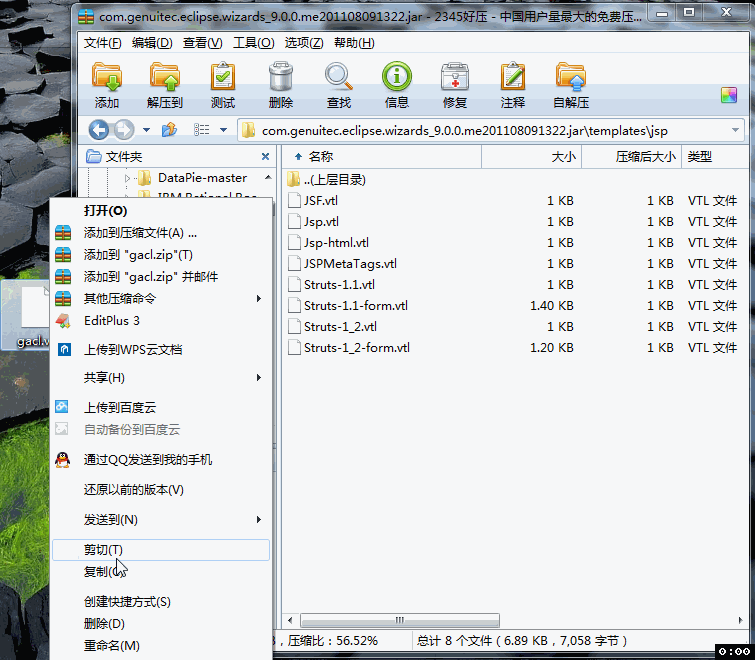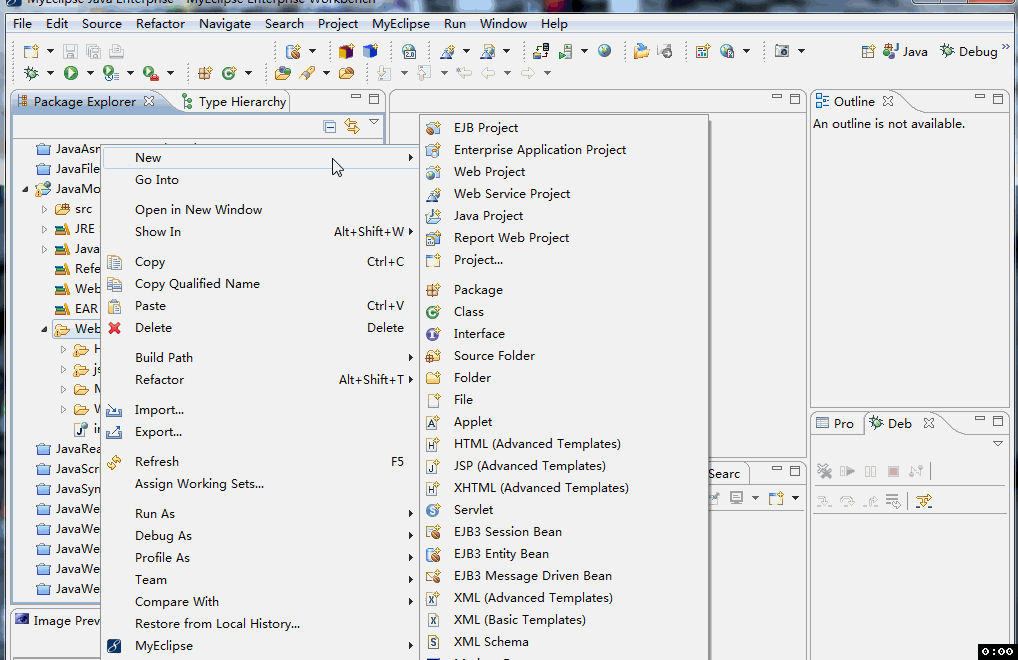一、修改Servlet的默认模板代码
使用MyEclipse创建Servlet时,根据默认的Servlet模板生成的Servlet代码如下:
1 package gacl.servlet.study;
2
3 import java.io.IOException;
4 import java.io.PrintWriter;
5
6 import javax.servlet.ServletException;
7 import javax.servlet.http.HttpServlet;
8 import javax.servlet.http.HttpServletRequest;
9 import javax.servlet.http.HttpServletResponse;
10
11 public class ServletDefaultTemplateCode extends HttpServlet {
12
13 /**
14 * The doGet method of the servlet. <br>
15 *
16 * This method is called when a form has its tag value method equals to get.
17 *
18 * @param request the request send by the client to the server
19 * @param response the response send by the server to the client
20 * @throws ServletException if an error occurred
21 * @throws IOException if an error occurred
22 */
23 public void doGet(HttpServletRequest request, HttpServletResponse response)
24 throws ServletException, IOException {
25
26 response.setContentType("text/html");
27 PrintWriter out = response.getWriter();
28 out.println("<!DOCTYPE HTML PUBLIC \"-//W3C//DTD HTML 4.01 Transitional//EN\">");
29 out.println("<HTML>");
30 out.println(" <HEAD><TITLE>A Servlet</TITLE></HEAD>");
31 out.println(" <BODY>");
32 out.print(" This is ");
33 out.print(this.getClass());
34 out.println(", using the GET method");
35 out.println(" </BODY>");
36 out.println("</HTML>");
37 out.flush();
38 out.close();
39 }
40
41 /**
42 * The doPost method of the servlet. <br>
43 *
44 * This method is called when a form has its tag value method equals to post.
45 *
46 * @param request the request send by the client to the server
47 * @param response the response send by the server to the client
48 * @throws ServletException if an error occurred
49 * @throws IOException if an error occurred
50 */
51 public void doPost(HttpServletRequest request, HttpServletResponse response)
52 throws ServletException, IOException {
53
54 response.setContentType("text/html");
55 PrintWriter out = response.getWriter();
56 out.println("<!DOCTYPE HTML PUBLIC \"-//W3C//DTD HTML 4.01 Transitional//EN\">");
57 out.println("<HTML>");
58 out.println(" <HEAD><TITLE>A Servlet</TITLE></HEAD>");
59 out.println(" <BODY>");
60 out.print(" This is ");
61 out.print(this.getClass());
62 out.println(", using the POST method");
63 out.println(" </BODY>");
64 out.println("</HTML>");
65 out.flush();
66 out.close();
67 }
68
69 }
在实际开发中,这些生成的代码和注释一般我们都用不到的,每次都要手工删除这些注释和代码,很麻烦,因此可以根据开发的实际情况修改Servlet的模板代码,改成符合实际开发需求的模板代码。下面以MyEclipse 10为例进行说明如何修改Servlet的模板代码
具体步骤如下:找到MyEclipse安装目录下的\Common\plugins文件夹,比如:D:\MyEclipse10\Common\plugins,然后找到com.genuitec.eclipse.wizards_9.0.0.me201108091322.jar这个jar文件,为了方便查找com.genuitec.eclipse.wizards_9.0.0.me201108091322.jar这个jar文件,建议使用【SearchEverything】这样的文件查找工具,如下图所示:
注意是打开不是解压这个jar包,如下图所示:
打开com.genuitec.eclipse.wizards_9.0.0.me201108091322.jar这个jar文件后,可以看到里面有一个templates文件夹,进入templates文件夹,可以看到里面有一个Servlet.java文件,如下图所示:
打开Servlet.java文件,可以看到里面的模板代码:
1 #---------------------------------------------#
2 # <aw:description>Template for Servlet</aw:description>
3 # <aw:version>1.1</aw:version>
4 # <aw:date>04/05/2003</aw:date>
5 # <aw:author>Ferret Renaud</aw:author>
6 #---------------------------------------------#
7
8 <aw:import>java.io.IOException</aw:import>
9 <aw:import>java.io.PrintWriter</aw:import>
10
11 <aw:import>javax.servlet.ServletException</aw:import>
12 <aw:import>javax.servlet.http.HttpServlet</aw:import>
13 <aw:import>javax.servlet.http.HttpServletRequest</aw:import>
14 <aw:import>javax.servlet.http.HttpServletResponse</aw:import>
15
16 <aw:parentClass>javax.servlet.http.HttpServlet</aw:parentClass>
17
18 <aw:constructor name="c1">
19 /**
20 * Constructor of the object.
21 */
22 public <aw:className/>() {
23 super();
24 }
25
26 </aw:constructor>
27
28 <aw:method name="doGet">
29 /**
30 * The doGet method of the servlet. <br>
31 *
32 * This method is called when a form has its tag value method equals to get.
33 *
34 * @param request the request send by the client to the server
35 * @param response the response send by the server to the client
36 * @throws ServletException if an error occurred
37 * @throws IOException if an error occurred
38 */
39 public void doGet(HttpServletRequest request, HttpServletResponse response)
40 throws ServletException, IOException {
41
42 response.setContentType("text/html");
43 PrintWriter out = response.getWriter();
44 out.println(
45 "<!DOCTYPE HTML PUBLIC \"-//W3C//DTD HTML 4.01 Transitional//EN\">");
46 out.println("<HTML>");
47 out.println(" <HEAD><TITLE>A Servlet</TITLE></HEAD>");
48 out.println(" <BODY>");
49 out.print(" This is ");
50 out.print(this.getClass());
51 out.println(", using the GET method");
52 out.println(" </BODY>");
53 out.println("</HTML>");
54 out.flush();
55 out.close();
56 }
57
58 </aw:method>
59
60 <aw:method name="doPost">
61 /**
62 * The doPost method of the servlet. <br>
63 *
64 * This method is called when a form has its tag value method equals to post.
65 *
66 * @param request the request send by the client to the server
67 * @param response the response send by the server to the client
68 * @throws ServletException if an error occurred
69 * @throws IOException if an error occurred
70 */
71 public void doPost(HttpServletRequest request, HttpServletResponse response)
72 throws ServletException, IOException {
73
74 response.setContentType("text/html");
75 PrintWriter out = response.getWriter();
76 out.println(
77 "<!DOCTYPE HTML PUBLIC \"-//W3C//DTD HTML 4.01 Transitional//EN\">");
78 out.println("<HTML>");
79 out.println(" <HEAD><TITLE>A Servlet</TITLE></HEAD>");
80 out.println(" <BODY>");
81 out.print(" This is ");
82 out.print(this.getClass());
83 out.println(", using the POST method");
84 out.println(" </BODY>");
85 out.println("</HTML>");
86 out.flush();
87 out.close();
88 }
89
90 </aw:method>
91
92 <aw:method name="doPut">
93 /**
94 * The doPut method of the servlet. <br>
95 *
96 * This method is called when a HTTP put request is received.
97 *
98 * @param request the request send by the client to the server
99 * @param response the response send by the server to the client
100 * @throws ServletException if an error occurred
101 * @throws IOException if an error occurred
102 */
103 public void doPut(HttpServletRequest request, HttpServletResponse response)
104 throws ServletException, IOException {
105
106 // Put your code here
107 }
108
109 </aw:method>
110
111 <aw:method name="doDelete">
112 /**
113 * The doDelete method of the servlet. <br>
114 *
115 * This method is called when a HTTP delete request is received.
116 *
117 * @param request the request send by the client to the server
118 * @param response the response send by the server to the client
119 * @throws ServletException if an error occurred
120 * @throws IOException if an error occurred
121 */
122 public void doDelete(HttpServletRequest request, HttpServletResponse response)
123 throws ServletException, IOException {
124
125 // Put your code here
126 }
127
128 </aw:method>
129
130 <aw:method name="init">
131 /**
132 * Initialization of the servlet. <br>
133 *
134 * @throws ServletException if an error occurs
135 */
136 public void init() throws ServletException {
137 // Put your code here
138 }
139
140 </aw:method>
141
142 <aw:method name="destroy">
143 /**
144 * Destruction of the servlet. <br>
145 */
146 public void destroy() {
147 super.destroy(); // Just puts "destroy" string in log
148 // Put your code here
149 }
150
151 </aw:method>
152
153 <aw:method name="getServletInfo">
154 /**
155 * Returns information about the servlet, such as
156 * author, version, and copyright.
157 *
158 * @return String information about this servlet
159 */
160 public String getServletInfo() {
161 return "This is my default servlet created by Eclipse";
162 }
163
164 </aw:method>
修改该模板,根据自己的实际情况进行修改,比如
删除doGet和doPost里面的代码和方法注释,在doPost方法里面调用doGet,这是根据实际情况修改成的模板代码,修改好之后,保存,重启MyEclipse,使用MyEclipse创建Servlet,此时就是用刚才修改过的模板进行生成了,生成的代码如下:
1 package gacl.servlet.study;
2
3 import java.io.IOException;
4
5 import javax.servlet.ServletException;
6 import javax.servlet.http.HttpServlet;
7 import javax.servlet.http.HttpServletRequest;
8 import javax.servlet.http.HttpServletResponse;
9
10 public class ServletNewTemplateCode extends HttpServlet {
11
12 public void doGet(HttpServletRequest request, HttpServletResponse response)
13 throws ServletException, IOException {
14
15 }
16
17 public void doPost(HttpServletRequest request, HttpServletResponse response)
18 throws ServletException, IOException {
19 doGet(request, response);
20 }
21
22 }
二、修改jsp的默认模板
同样也是找到com.genuitec.eclipse.wizards_9.0.0.me201108091322.jar这个jar文件,用压缩工具打开,进入templates\jsp文件夹,可以看到MyEclipse自带的那些jsp模板,如下图所示:
这些jsp模板是MyEclipse自带的,我们也可以依样画葫芦,根据平时项目开发中的实际情况,创建一个jsp模板,然后添加到jsp目录中,操作步骤如下:
1、随便复制一个jsp模板出来(如:Jsp.vtl),复制到系统的桌面或者系统的其他盘进行存储
2、修改复制出来的模板,使用记事本或者editplus打开Jsp.vtl,可以看到Jsp.vtl的模板代码,如下所示:
1 #*---------------------------------------------#
2 # Template for a JSP
3 # @version: 1.2
4 # @author: Ferret Renaud
5 # @author: Jed Anderson
6 #---------------------------------------------#
7 *#<%@ page language="java" import="java.util.*" pageEncoding="$encoding"%>
8 <%
9 String path = request.getContextPath();
10 String basePath = request.getScheme()+"://"+request.getServerName()+":"+request.getServerPort()+path+"/";
11 %>
12
13 <!DOCTYPE HTML PUBLIC "-//W3C//DTD HTML 4.01 Transitional//EN">
14 <html>
15 <head>
16 <base href="<%=basePath%>">
17
18 <title>My JSP '$title' starting page</title>
19
20 #parse( "templates/jsp/JSPMetaTags.vtl" )
21 </head>
22
23 <body>
24 This is my JSP page. <br>
25 </body>
26 </html>
这是Jsp.vtl的模板原始代码,这个模板的代码对于我来说不太符合项目开发中的实际情况,需要修改,修改后的模板如下:
1 #*---------------------------------------------#
2 # Template for a JSP
3 # @version: 1.2
4 # @author: 孤傲苍狼
5 #---------------------------------------------#
6 *#<%@ page language="java" pageEncoding="UTF-8"%>
7 <!DOCTYPE HTML>
8 <html>
9 <head>
10 <title></title>
11 </head>
12
13 <body>
14
15 </body>
16 </html>
为了避免覆盖原来的Jsp.vtl模板,将修改后的Jsp.vtl模板重命名,例如重命名成gacl.vtl。
3.将gacl.vtl模板复制,然后粘贴到com.genuitec.eclipse.wizards_9.0.0.me201108091322.jar包里面的templates\jsp文件夹里。

4、从查看解压文件的界面中,返回到根目录(即com.genuitec.eclipse.wizards_9.0.0.me201108091322.jar目录),找到模版配置文件templates.xml,如下图所示:
同样,将templates.xml文件复制到桌面,使用记事本或者editplus打开进行修改。
修改如下:在<templateLibrary>里添加如下元素:
1 <template
2 context="com.genuitec.eclipse.wizards.jsp"
3 script="templates/jsp/gacl.vtl"
4 name="gacl-JSP template"/>
其中:
1、templates/jsp/gacl.vtl:为新添加的jsp模板的相对路径。
2、gacl-JSP template:为MyEclipse中所要标识的模版名称,MyEclipse新建JSP文件时通过这个名字来选择对应的模版。
3、context="com.genuitec.eclipse.wizards.jsp"
templates.xml修改后的内容如下图所示:
com.genuitec.eclipse.wizards_9.0.0.me201108091322.jar包中的templates.xml文件删除掉,然后将修改过后的templates.xml复制,粘贴到com.genuitec.eclipse.wizards_9.0.0.me201108091322.jar包中,如下图所示:

到此,我们的Jsp模板就算是创建好了。
6.启动MyEclipse,然后新创建一个Jsp页面,此时就可以使用我们自定义的那个Jsp页面模板了,如下图所示:

通过以上两种方式,我们在开发的时候,就可以根据我们自己的开发习惯来定制servlet和jsp的模板了,对于开发效率上或多或少有一点提高吧,不用每次都把MyEclipse生成的很多用不到的代码删掉。
























